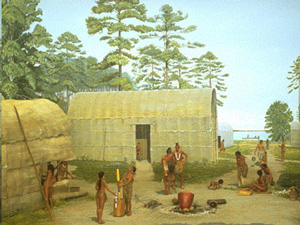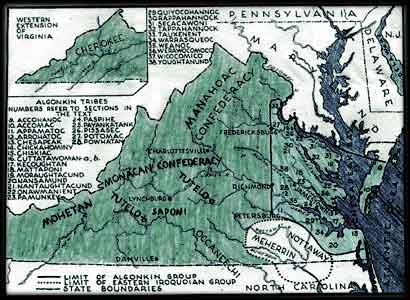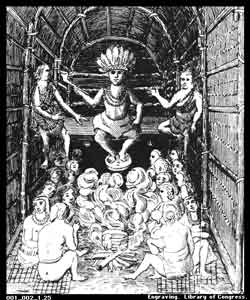Powhatan
Entry from The Indian Tribes of North America by John R. Swanton
The Indian Tribes
of North America by John Reed Swanton [ Pub Washington
: U.S.G.P.O., 1952]
The Following is
from the
greater context of Virginia Indians by John R Swanton and is
unedited , minus a few typos, as presented
Powhatan
Said by Gerard to signify "falls in a
current of water," and applied originally to one tribe but extended by
the English to its chief Wahunsonacock, and through him to the body of
tribes which came under his sway.
Also called: Sachdagugh-roonnw, Iroquois
name.
Connections.- The Powhatan belonged
to the Algonquian linguistic stock, their nearest relatives probably being
the Algonquian tribes of Carolina and the Conoy.
Location.- In the tidewater section
of Virginia from Potomac River to the divide between James River and Albemarle
Sound, and the territory of the present eastern shore of Virginia.
(See also Maryland and District of Columbia.)
Subdivisions
Subtribes constituting this group are as follows:
Accohanoc, in Accomao and part of Northampton Counties, Va., and probably
extending slightly into Maryland.
Accomac, in the southern part of Northampton County, Va.
Appomattoc, in Chesterfield County.
Arrohattoc, in Henrico County.
Chesapeake, in Princess Anne County.
Chickahominy, on Chickahominy River.
Chiskiac, in York County.
Cuttatawomen, in King George County.
Kecoughtan, in Elizabeth City County.
Mattapony on Mattapony River.
Moraughtacund, in Lancaster and Richmond Counties.
Mummapacune, on York River.
Nansemond, in Nansemond County.
Nantaughtacund, in Essex and Caroline Counties.
Onawmanient, in Westmoreland County.
Pamunkey, in King William County.
Paspahegh, in Charles City and James City Counties.
Pataunck, on Pamunkey River.
Piankatank, on Piankatank River.
Pissasee, in King George and Westmoreland Counties.
Potomac, in Stafford and King George Counties.
Powhatan, in Henrico County.
Rappahannock, in Richmond County.
Secacawoni, in Northumberland County.
Tauxenent, in Fairfax County.
Warrasqueoc, in Isle of Wight County.
Weanoe, in Charles City County.
Werowcomoco, in Gloucester County.
Wicocomoco, in Northumberland County.
Youghtanund, on Pamunkey River.
Villages
Accohanoc, on the river of the same name in Accomac or Northampton Counties.
Accomac, according to Jefferson (1801), about Cheriton, on Cherrystone
Inlet, Northampton County.
Acconoe, between Chickahominy and Pamunkey Rivers, in New Kent County.
Accoqueck, on Rappahannock River, above Secobec, in Caroline County.
Accossuwinck, on Pamunkey River, King William County.
Acquack, on the north bank of Rappahannock River, in Caroline County.
Appamattoc, on the site of Bermuda Hundred, in Prince George County.
Appocant, on the north bank of Chickahominy River, in New Kent County.
Arrohattoc, in Henrico County on the James River, 12 miles below the falls
at Richmond.
Askakep, near Pamunkey River in New Kent County.
Assaomeck, near Alexandria.
Assuweska, on the north bank of the Rappahannock in King George County.
Attamtuck, between the Chickahominy and Pamunkey Rivers in New Kent County.
Aubomesk, on the north bank of the Rappahannock in Richmond County.
Aureuapeugh, on Rappahannock River in Essex County.
Cantaunkack, on York River in Gloucester County.
Capahowasic, about Cappahosic in Gloucester County.
Cattachiptico, on Pamunkey River in King William County.
Cawwontoil, on the north bank of the Rappahannock River in Richmond County.
Chawopo, at the mouth of Chipoak Creek, Surry County.
Checopissowo, on Rappahannock River above Tobacco Greek, in Caroline County.
Chesakawon, above the mouth of Corotoman River, in Lancaster County.
Chesapeake, according to Jefferson on Linnhaven River in Princess Anne
County a small stream flowing north into Chesapeake Bay.
Chiconessex, about Wiseville, in Accomac County.
Chincoteague, about Chincoteague Inlet, in Accomac County.
Chiskiac, on the south side of York River, about 10 miles below the junction
of the Mattapony and Pamunkey.
Cinquack, near Smiths Point on the Potomac, in Northumberland County.
Cinquoteek, in the fork of Mattapony and Pamunkey Rivers, in King William
County.
Cuttatawomen, (1) on the Rappahannock River at Corotoman River in Lancaster
County; (2) about Lamb Creek on the Rappahannock, in King George County.
Gangasco, near Eastville, in Northampton County.
Kapawnich, on the north bank of the Rappahannock, about Corotoman River
in Lancaster County.
Kerahocak, on the north bank of the Rappahannock River in King George County.
Kiequotank, on the eastern shore of Accomac County, north of Metomkin.
Kupkipcock, on Parnunkey River in King William County.
Machapunga, (l) in Northampton County; (2) on Potomac River.
Mamanahunt, on Chickahominy River, in Charles City County.
Mamanassy, at the junction of Pamunkey and Mattapony Rivers in King and
Queen County.
Mangoraca, on the north bank of the Rappahannock in Richmond County.
Mantoughquemec, on Nansemond River, in Nansemond County.
Martoughquaunk, on Mattapony River in Caroline County.
Massawoteck, on the north bank of Rappahannock River in King George County.
Matchopick, on the north bank of the Rappahannock River in Richmond County.
Matchut, on Pamunkey River, in New Kent County.
Mathomauk, on the west bank of James River, in Isle of Wight County.
Matomkin, about Metomkin Inlet in Accomac County.
Mattacock, on the north bank of York River in Gloucester County.
Mattacunt, on the south side of Potomac River in King George County.
Mattanock, on the west side of Nansemond River, near its mouth, in Nansemond
County.
Maysonec, on the north bank of the Chickahominy in New Kent County.
Menacupunt, on Pamunkey River, in King William County.
Menaskunt, on the north bank of Rappahannock River in Richmond County.
Meyascosic, on the north side of James River in Charles City County.
Mohominge, near the falls of James River, in Richmond County.
Mokete, on Warrasqueoc Creek, in Isle of Wight County.
Moraughtacund, near the mouth of Moratico River in Richmond County.
Mouanast, on the north bank of Rappahannock River, in King George County.
Mutchut, on the north bank of the Mattapony River in King and Queen County.
Muttamussinsack, on the north bank of Rappahannock River in Caroline County.
Myghtuckpassu, on the south bank of Mattapony River in King William County.
Namassingakent, on the south bank of Potomac River in Fairfax County.
Nameroughquena, on the south bank of the Potomac River in Alexandria County,
opposite Washington, D. C.
Nansemond, probably about Chuckatuck in Nansemond County.
Nantapoyac, on the south bank of James River in Surry County.
Nantaughtacund, on the south side of the Rappahannock River in either Essex
County or Caroline County.
Nawacaten, on the north bank of the Rappahannock River in Richmond County.
Nawnautough, on the north bank of the Rappahannock River in Richmond County.
Nechanicok, on the south bank of the Chickahominy in the lower part of
Henrico County.
Nepawtacum, on the north bank of the Rappahannock in Lancaster County.
Onancock, near Onancock in Accomac County.
Onawrnanient, probably on Nominy Bay, in Westmoreland County.
Opiscopank, on the south bank of the Rappahannock River in Middlesex County.
Oquomock, on the north bank of the Rappahannock River in Richmond County.
Orapaks, in New Kent County, between the Chickahominy and Pamunkey Rivers.
Ottachugh, on the north bank of the Rappahannock River in Lancaster County.
Ozatawomen, on the south bank of the Potomac River in King George County.
Ozenic, on Chickahominy River in New Kent County.
Pamawauk, perhaps identical with Pamunkey.
Pamuncoroy, on the south bank of Pamunkey River in New Kent County.
Pamunkey, probably near West Point in King William County.
Papiscone, on the north bank of the Rappahannock in King George County.
Pasaugtacock, on the north bank of York River in King and Queen County.
Paspahegh, (1) on the south bank of Chickahominy River in Charles City
County; (2) on the north bank of James River in Charles City County.
Passaunkack, on the south bank of Mattapony River in the northwestern part
of King William County.
Pastanza, on or near Potomac River, possibly on Aquia Creek, in Stafford
County.
Pawcocomac, on the north bank of Rappahannock River at the mouth of the
Corotoman in Lancaster County.
Pecearecamek, an Indian settlement reported on the southernVirginia border,
perhaps mythical.
Pemacocack, on the west bank of Potomac River in Prince William County
about 30 miles below Alexandria.
Piankatank, on Piankatank River in Middlesex County.
Pissacoac, On the north bank of Rappahannock River above Leedstown in Westmoreland
County.
Poruptanck, on the north bank of York River in Gloucester County.
Potaucac, in New Kent County between the Chickahominy and Pamunkey Rivers.
Potomac, about 55 miles in a straight line from Chesapeake Bay, on a peninsula
in what is now Stafford County, formed by Potomac River and Potomac Creek.
Powcomonet, on the north bank of Rappahannock River in Richmond County.
Powhatan, on the north bank of James River at the falls on ground now forming
an eastern suburb of Richmond.
Poyektauk, on the north bank of Rappahannock River in Richmond County.
Poykemkack, on the north bank of Rappahannock River in Richmond County.
Pungoteque, in Accomac County, probably near Metomkin Inlet.
Quackcohowaon, on the south bank of the Mattapony in King William County.
Quioucohanock, probably on an eminence now called Wharf Bluff just east
of Upper Chipoak Creek in Surry County.
Quiyough, on the south bank of Aquia Creek near its mouth, in Stafford
County.
Rappahannock, at the mouth of a creek on Rappahannock River in Richmond
County.
Rickahake, probably in Norfolk County.
Righkahauk, on the west bank of Chickahominy River in New Kent County.
Ritanoe, probably Powhatan, in Virginia or North Carolina.
Roscows, in Elizabeth City County.
Secacawoni, at the mouth of Coan Creek on the south bank of the Potomac
in Northumberland County.
Secobeck, on the south bank of Rappahannock River in Caroline County.
Shamnpa, on Pamunkey or York River.
Sockobeck, on the north bank of Rappahannock River in King George County.
Tantucquask, on Rappahannock River in Richmond County.
Tauxenent, about Mount Vernon in Fairfax County.
Teracosick, on the west bank of Nansemond River in Nansemond County.
Utenstank, on the north bank of Mattapony River in Caroline County.
Uttamussac, on the north bank of Pamunkey River in King William County.
Uttamussamacoma, on the south bank of Potomac River inWestmoreland County.
Waconiask, on the north bank of Rappahannock River in King George County.
Warrasqueoc, on the south bank of James River at the mouth of
Warrasqueoc Creek in Isle of Wight County.
Weanoc, below the mouth of Appamattox River at the present Weyanoke in
Prince George County.
Wecuppom, on the north bank of Rappahannock River in Richmond County.
Werawahon, on the north bank of Chickahominy River in New Kent County.
Werowacomoco, on the north bank of York River in Gloucester County about
opposite the mouth of Queen Creek.
Wicocomoco, at the mouth of Wicomico River in Northumberland County.
Winsack, on the north bank of Rappahannock River in Richmond County.
History.-
The Powhatan were visited by some very
early explorers, including probably the Cabots in 1498. Their territory
was well known to the Spaniards in the latter part of the sixteenth century
and a Jesuit mission was established among them in 1570 though soon extinguished
by the Indians. In 1607 the Virginia colony was planted on James River
and from that time on relations between the Whites and Powhatans were of
the most intimate character, friendly at first, but later disturbed by
the
exactions of the newcomers. Peace was
restored for a lime by the marriage of Powhatan's daughter Pocahontas to
John Rolfe, and lasted until Powhatan's death in 1618. In 1622 Powhatan's
second successor, Opechancanough, led an uprising against the colonists,
as a result of which all of the White settlements except those immediately
about Jamestown were destroyed. War continued until1636 when exhaustion
of both sides led to peace, but in 1644 Opechnncanough led another uprising
as destructive as the first.He was captured and was killed the same year.
The tribes made peace separately, and they were placed upon reservations,
where they gradually dwindled away. In 1654 or 1656 the Pamunkey assisted
the English in resisting an invasion of some inland people, but the allied
army was severely defeated (see Manahoac).
In 1675 these Indians were accused of
having committed certain depredations, really caused by the Conestoga,
and several unauthorized expeditions were led against them by Nathaniel
Bacon. In August 1676 a great body of them gathered in a fort near Richmond
which was carried by storm, and men, women, and children indiscriminately
massacred. Peace was made with the survivors on condition that an annual
tribute be paid by each village. In 1722 in a treaty made at Albany between
the English and Iroquois,
the latter agreed to cease their attacks upon the Powhatan Indians, but
the Powhatans already had been greatly reduced and they continued to decline.
Those on the eastern shore of Virginia, who had become very much mixed
with Negroes, were driven away in 1831 during the excitement caused by
the slave rising under Nat Turner. In 1785 Jefferson reported the Powhatan
Indians reduced to two tribes, the Pamunkey
and Mattapony, embracing only about 15 men, but he must have overlooked
great numbers of these Indians, for at the present time there are several
bands, including the Chickahominy, Nansemond, Pamunkey, Mattapony, Upper
Mattapony, Rappahannock, Wicocomoco, Potomac, Powhatan, and Werowocomoco
(Speck, 1925).
Population.-
The Powhatan population was estimated
by Mooney (1928) as 9,000 in 1600; Smith (1884) allows them 2,400 warriors;
in 1669 a census gave 528 warriors or about 2,000 population, the Wicocomoco
being then the largest tribe. In 1705 the Pamunkey by themselves numbered
150 souls. Jefferson in 1785 represented the two tribes which he
mentions as having but 15 men; Mooney, however, believed that there must
have been a population of something like 1,000 because of the number
of mixed-bloods still surviving. The census of 1910 returned 115 Chickahominy
and 85 Pamunkey. The United States Office of Indian Affairs Report for1923
includes still other bands, giving in all a population of 822, and Speck
(1925) gives the names of 10 bands aggregating 2,118 in 1923. The census
of 1930 returned only 203 Indians from Virginia but evidently missed nearly
all except the Pamunkey.
Connection in which they have
become noted.-
The Powhatan Confederacy is famous as
embracing those Indians among whom the first permanent English settlement
in North America was made; for the personal character of its chief, Powhatan,
who had conquered about 24 tribes, in addition to the 6 under him at his
accession, before the appearance of the Europeans; on account of the dealings
of the Whites with both Powhatan and his brother Opechancanough, as well
as the massacre of the settlers by the latter in 1622 and again in 1644;
and not least from the fame attached to Powhatan's daughter, Pocahontas.
There are post villages named Powhatan in Jefferson County, Ala.; Lawrence
County, Ark.; Natchitoches Parish, La.; McDowell County, W. Va.; a county
and county seat of the name in Virginia; Powhatan Point
in Belmont County, Ohio; and Powhattan
in Brown County, Kans. |




